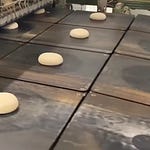Milk bread, often associated with Japanese shokupan, is known for its exceptionally soft, tender crumb and delicate structure.
While the classic recipe contains flour, yeast, sugar, salt, butter, milk, and eggs, what truly sets milk bread apart is the combined action of milk and eggs. These two ingredients reshape the dough’s rheology and gluten behavior, creating the signature pillowy texture.
Rheology and Gluten Structure
Milk bread is an enriched dough; it contains fats, sugars, and dairy solids that significantly influence dough behavior, altering both strength and extensibility. These doughs show:
Higher extensibility, the dough stretches easily without tearing.
Reduced elasticity, gluten bonds are moderated by fats and sugars.
Increased water absorption, leading to a moist, supple dough.
A finer, more uniform crumb structure.
These rheological properties give the dough its characteristic softness and ability to form long, delicate strands inside the finished loaf.
The Function of Milk in Dough Rheology
Milk modifies dough rheology through the combined action of lactose, proteins, lipids, and minerals. These components interact with gluten and starch systems in ways that alter viscoelastic behavior.
Lactose acts as a non-fermentable carbohydrate (by yeast) that increases water binding and actively promotes Maillard reactions, which drive non-enzymatic browning and flavor development during baking.
Milk lipids coat the surface of gluten proteins, making it harder for them to link together. This reduces the formation of new S–S bonds, so the gluten network becomes softer, less elastic, and more tender.
Casein and whey proteins compete with gluten proteins for available water, modifying hydration dynamics. They also contribute to a more plastic, less elastic dough by interrupting gluten network continuity.
The natural acidity of milk slightly lowers dough pH, which reduces the negative charge on gluten proteins. With less repulsion, the proteins move closer and form more intermolecular bonds, tightening the gluten network. Milk lipids moderate this tightening by coating the proteins, helping the dough remain flexible and easier to stretch.
Heating milk or using milk powder denatures whey proteins, preventing them from weakening gluten bonding. As a result, the dough retains structural stability while exhibiting increased tenderness and a fine, even crumb.
The result is a dough that remains stable but tender, capable of producing a light, even crumb.
The Function of Eggs in Dough Rheology
Eggs influence dough rheology through their proteins, lipids, and emulsifiers, each affecting the gluten network in specific ways.
Egg white proteins unfold during mixing and heat, forming a coagulated protein matrix that reinforces gas cell walls and improves gas retention.
Yolk lipids coat gluten proteins, reducing protein-protein contact and limiting new cross-links. This increases tenderness and reduces excessive elasticity.
Lecithin is an emulsifier that form molecular bridges between water and fat phases, allowing lipids to disperse more uniformly through the dough. This improves dough stability, enhances gluten lubrication, and increases extensibility without weakening structure.
Thermal coagulation of egg proteins during baking stabilizes cell structure and contributes to loaf volume by strengthening the walls of expanding gas bubbles.
Together, these effects create a dough that is strong enough to rise effectively while maintaining the soft, fine crumb characteristic of milk bread.
Addition of Tangzhong or Water Roux to the Recipe
This is a pre gelatinized paste made from flour and liquid, often added to milk bread formulas to enhance softness.
Increases water retention in the dough.
Produces a moister, more elastic crumb.
Delays staling by keeping starches hydrated.
Improves dough handling and tolerance.
By raising the dough’s hydration capacity, Water Roux creates an exceptionally soft crumb that remains plush for longer periods compared to standard enriched breads.
👉 Thanks for reading! 💬 Any experiences to share with us?? – We’d love to hear your story!
Source: https://tinyurl.com/34kzt4ep
https://tinyurl.com/5be693z9










